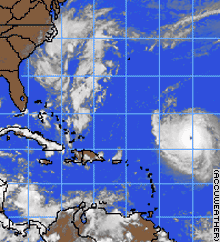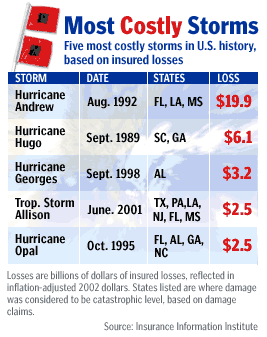NEW YORK (CNN/Money) -
Hurricane Isabel poses a threat not only to residents and businesses along the East Coast but also to the nation's insurance industry, which could easily see billions of dollars in loss claims from the storm.
The hurricane, now in the mid-Atlantic almost 2,000 miles from Miami, increased in intensity Thursday to become the most powerful Atlantic storm in nearly five years, according to the National Hurricane Center. Isabel's sustained winds were near 160 miles per hour, making it a Category 5 storm, the highest designation on the Saffir-Simpson hurricane scale.
 |
|
| Isabel could be the most powerful storm to hit the United States since Hurricane Andrew 11 years ago. |
Only three storms to hit the United States have ever been given the Category 5 ranking -- Hurricane Andrew, the nation's most expensive natural disaster, in 1992; Hurricane Camille, which hit the Gulf Coast in 1969, and an unnamed storm that hit the Florida Keys in 1935. And Andrew wasn't upgraded to a Category 5 storm until 2002.
The National Hurricane Center called Isabel "extremely dangerous," though it said the storm remains days away from any potential landfall. (Click here for CNN.com's coverage of Hurricane Isabel)
Even if Isabel lives up to its potential as one of the nation's most powerful and destructive storms ever, experts say the insurance industry is in better shape to weather the damage and pay claims than it was before Andrew slammed into southeast Florida and the Gulf Coast in August 1992.
Andrew caused $15.5 billion in insured losses, equivalent to about $19.9 billion in insured losses in 2002 dollars. It caused a dozen insurers to go out of business and many big insurers to seek infusions of capital from their corporate parents in order to cover claims.
Insurance experts say that the lessons learned by the industry go beyond offering residents of hurricane-prone areas financial incentives, and advice on how to prepare their homes, to better weather major storms. Insurers have done more to make sure their exposure to any one major storm is far more limited.
"A Category 5 will cause substantial damage if it hits a populated area," said Andrew Colannino, assistant vice president with insurance rating firm AM Best. "But as far as individual companies mitigating their catastrophic risk, they have come a long way since Andrew."

A Category 5 hitting Miami-South Florida head on could cause $50 billion in insured damages, according to estimates done by AIR Worldwide Corp., a catastrophe research firm serving the insurance industry. That would be the most expensive disaster in United States history, topping an estimated $40 billion of insured losses for the Sept. 11 terrorist attack.
But a slight change in direction can save tens of billions -- if Category 5 Hurricane Andrew came ashore along the identical path today that it followed 11 years, a path that put it about 30 to 50 miles south of Miami, it would cause $25 billion in losses, according to AIR's model.
At this point it seems unlikely that Isabel could hit South Florida head on, and much of the area north of that heavily populated region is fairly rural.
"If it came ashore in a rural area, it could be just a few billion dollars," said AIR's Jayanta Guin. "It (insured loss) is very sensitive to where it actually makes landfall."
It's unlikely that any hurricane could maintain Category 5 winds if it got as far north as the New York metropolitan area or New England. But the dense population there and other characteristics of a more northern hurricane strike could drive up insured losses again, said Guin.
"It's much weaker, but the size of the storm tends to grow," said Guin. "Even a category 3 could cause $25 billion in damage."
Colannino said insurers have learned to spread their client base across a wider geographic area to insure that one natural disaster doesn't hit too large a percentage of their clients.
They've also turned more to the reinsurance market, covering a portion of their own risk. Reinsurers provide coverage to insurance companies. And in some hurricane-prone areas, such as Florida, deductibles today are a percentage of the claim, rather than a fixed amount, which also can limit the insurance claims by thousands of dollars per customer in case of the most damaging storm.
"In general, most companies that are writing insurance in coastal areas have done extensive modeling to limit their exposure," he added. "The highest-rated insurers should be able to handle even a Category 5 for the most part."
The industry and residents in some places such as Florida also have more extensive public programs to help cover the risk of a major storm. For example Florida has both a public insurance program to help those with homes or other property near the coast who can't find hurricane coverage in the private market. It also has a quasi-public reinsurance fund for insurers that could raise as much as $11 billion in the case of a major hurricane.
One advantage for insurers is that the nation has been basically spared major storms in recent years.
When Hurricane Lili hit the Gulf Coast last October, causing $430 million in insured damage, it was the first hurricane to hit since 1999. That two year respite is relative rare -- AIR estimates the chance of going two or more years without a hurricane hitting the United States is only 5.5 percent, only slightly more likely than the 3.5 percent chance of a Category 5 hitting in any one particular year.
But some other major storms, including less severe tropical storms and weather fronts that produced a rash of tornados, have taken their toll in recent years.
Tropical Storm Allison, which cut across 20 states from Texas to New Jersey in June 2001, did $2.5 billion in damage, more than caused by all but three U.S. hurricanes in history, even when damage is adjusted for inflation.
Still, even more damaging than any one storm to insurers' fiscal health has been the decline in the stock market that began in 2000, reducing the value of their holdings.
AM Best's estimates of industry-wide surpluses stood at $334 billion at the end of 1999 and was down to $317 billion by the end of 2000. By the end of 2001, with further declines in the market and the impact of the Sept. 11 terrorist attack, the surplus sank to $290 billion and was basically flat last year, ending 2002 at $291 billion.
"Being free of hurricanes the last several years has helped [the insurance industry] but other things have negatively impacted capital positions of companies, like the stock market and underwriting losses," said Colannino.

|

